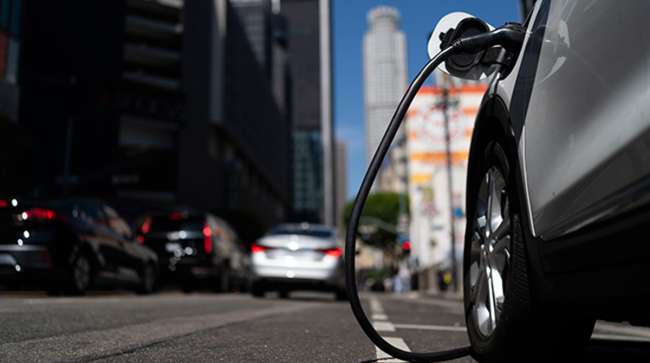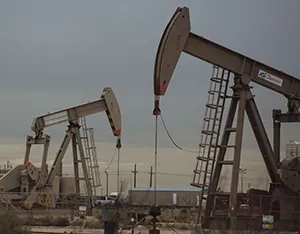Bloomberg News
Here’s What a Trump Presidency Means for EVs, Oil

[Stay on top of transportation news: Get TTNews in your inbox.]
Donald Trump’s victory promises to shake up U.S. energy and environmental policy, with sweeping implications for oil production, offshore wind development and electric vehicle sales.
The win empowers him to deliver on his campaign pledges to go after climate policies he has dubbed the “green new scam” while reorienting the federal government toward pumping more crude and building more power plants. Though some efforts would face long odds on Capitol Hill — where many of Trump’s fellow Republicans would oppose a wholesale repeal of the Inflation Reduction Act’s energy and manufacturing tax credits — Trump can use his executive authority to put other changes in motion. Oil and gas companies are set to be prime beneficiaries.
“You are looking at, overall, a ‘drill baby drill’ philosophy,” said Dan Eberhart, CEO of oilfield services company Canary. “You are going to see offshore lease sales, you are going to see pipelines move much quicker, you are going to see fracking on federal lands and a mindset that is focused on lowering energy costs for consumers.”
Here are some of the expected changes:
EVs
Trump has repeatedly promised to end a suite of federal policies that encourage EV sales, and his victory creates an opening for changes as soon as day one.
A top target is an Environmental Protection Agency regulation limiting tailpipe pollution from cars and light trucks, which has mandates so strict it compels automakers to sell far more electric and plug-in hybrid models over time. Former Trump advisers and energy lobbyists have already drafted language that could be put in an executive order directing the EPA to revisit the rule. A similar effort is being developed to go after Clean Air Act waivers that effectively green light California’s strict car pollution rules.
Oil-refining advocates also are lobbying for swift changes to limit which EVs qualify for tax credits under current Treasury Department policies. That presages a revamp of a policy, derided as the “leasing loophole,” which exempts leased EVs in commercial fleets from restrictions on where the cars are made, the source of their battery materials and how much money consumers make.
Oil and Gas
Trump promised to “unleash American energy” and said he has plans to “free up the vast stores of liquid gold on America’s public land for energy development.”

Oil and gas companies are set to be prime beneficiaries in a Trump administration. (Angus Mordant/Bloomberg)
That signals a sharp pivot from President Joe Biden’s policies curtailing fossil-fuel extraction on public lands and waters. Under Biden, the U.S. developed the smallest-ever plan for selling offshore oil and gas leases, with just three auctions scheduled over five years. The Biden administration also imposed a regulation thwarting drilling across more than half of the National Petroleum Reserve in Alaska.
Trump can direct his Interior Department to revise those policies right away, though it could take as long as two years for the agency to finish necessary environmental reviews and clear other procedural requirements before it could impose a new, more robust schedule for selling offshore drilling rights.
Changes in the governance of the Alaska reserve could be especially significant for oil companies with holdings or interests there, including ConocoPhillips, Santos Ltd., Repsol SA and Armstrong Oil & Gas Inc.
LNG Exports
A Biden administration moratorium on new permits to widely export liquefied natural gas is all but out the window thanks to Trump’s victory.
Trump has promised to end that permitting pause his “very first day back.” That could take the form of an executive order directing the Energy Department to resume its review of applications to export natural gas to key Asian nations and other countries that aren’t free-trade partners with the U.S.
Potential beneficiaries include Venture Global LNG Inc., Energy Transfer LP and Commonwealth LNG, which have projects pending before the agency.
Offshore Wind
Trump hasn’t spelled out exactly how he’ll address the nascent offshore wind industry, as developers work to install turbines at multibillion-dollar wind farms up and down the U.S. East Coast.
McLeod Software CEO Tom McLeod explores the potential for artificial intelligence to boost efficiency and build resilience. Tune in above or by going to RoadSigns.ttnews.com.
But Trump has been relentlessly critical of the potential impacts on birds and whales, and he used a New Jersey rally earlier this year to vow “day one” action targeting the industry. That could take the form of ordering the Interior Department pause permitting new projects or selling new offshore wind leases. Such a moratorium could be imposed administratively and would be difficult to challenge in court.
Wind energy advocates have been bracing for this election outcome and are planning to enlist Republican allies — including lawmakers whose districts have seen economic dividends from shipbuilding and steelmaking — in making the case for continued support.
Clean Energy Tax Credits
Trump’s victory creates new uncertainty for billions of dollars of clean energy tax credits. Congress isn’t likely to claw back all unspent funding from Biden’s signature climate law, nor repeal all of the IRA’s energy and manufacturing tax credits. But lawmakers from both parties could target some of the law’s incentives for phase-downs and scale-backs as a way to help pay for the cost of extending the 2017 Trump-era tax cuts that expire next year.
Under Trump, the Treasury Department is expected to rewrite rules governing which projects and companies are eligible for credits so they are harder to obtain — or more beneficial to fossil fuels. A tax credit that rewards the production of so-called green hydrogen is especially ripe for such a change, after years of lobbying by oil companies and other would-be developers seeking more flexibility in how they make the clean-burning fuel.
U.S. manufacturing allies already have developed plans that a Trump Treasury Department could use to bar companies with ties to China from claiming the IRA’s energy manufacturing tax credits.
High-Tech Loans
Trump’s victory puts a clean-tech green bank at the Energy Department in serious jeopardy.
He proposed killing the so-called Loan Programs Office during his first term in the White House, arguing the government had no business picking winners and losers. And congressional Republicans have a long history going after the program, deriding its performance partly based on a half-billion-dollar loan to Solyndra two years before the solar panel maker went bankrupt. Now, the office is flush with hundreds of billions of dollars in loan-backing authority thanks to the IRA, making it an even bigger target.
Trump will be under dueling pressure to either kill off the program, ending a major source of support for green-technology commercialization, or to keep it running, just with a decidedly pro-fossil-fuel bent. Advocates of the latter approach say the office has made billions of dollars in interest for the federal government and that its support can be used to back natural gas, carbon capture and nuclear energy ventures.
Power Plants
The president-elect has repeatedly vowed to “terminate” a suite of EPA rules that stifle power-plant pollution and encourage the closure of units generating electricity from coal, arguing that surging demand from artificial intelligence and manufacturing means the U.S. needs to be building more of the units, not shutting them down.
Want more news? Listen to today's daily briefing above or go here for more info
Thanks to AI, we’ll “need twice the amount of electricity currently supplied for everything to the entire United States of America,” Trump said in an August news conference.
A 2024 rule that limits emissions from the nation’s existing coal plants and new gas-fired units will be a top focus. Utilities, electric cooperatives and some states are already challenging the measure in federal court, potentially providing an easier opening for the EPA to begin rewriting the regulation in ways that prolong the lifespan of some coal plants.
The agency also is expected to hit the pause button on its work developing new greenhouse gas emission limits for existing gas-fired power plants.





